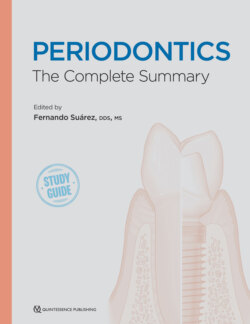Читать книгу Periodontics - Fernando Suarez - Страница 13
На сайте Литреса книга снята с продажи.
ALVEOLAR BONE
ОглавлениеOne of the two mineralized tissues that comprises the attachment apparatus is the alveolar bone. Just like any other type of bone in the human body, it is composed of a mineralized matrix and a nonmineralized connective tissue. Within the mineralized tissues, calcium is the most prevalent mineral in the form of hydroxyapatite. The alveolar bone, also known as alveolar process, consists of spongy bone, cortical plates, and the alveolar bone proper (Table 1-2). The crest of the alveolar bone refers to the most coronal portion of it, and its distance from the cementoenamel junction (CEJ) in a healthy periodontium is within the range of 1 to 3 mm.
TABLE 1-2 Features of alveolar bone
The alveolar bone is created following an intramembranous ossification with ectomesenchymal cells from the dental follicle intervening in the developmental process. The presence of teeth is essential for the development of the alveolar bone. As such, in absence of a PDL, the alveolar bone proper will not develop.5
The alveolar bone houses the teeth, providing protection and support and allowing proper functioning during mastication, absorbing and distributing the occlusal forces. The primary function of the alveolar bone is to provide a structure where the Sharpey fibers of the PDL anchor to keep the tooth in position and function.
The chemical composition of alveolar bone is 65% hydroxyapatite and 35% organic material such as collagen and noncollagenous proteins (eg, osteocalcin, bone sialoprotein, phosphoprotein, osteonectin, and bone morphogenetic proteins).
Microscopically, two different types of mature bone can be observed based on the organization: (1) the lamellar bone, containing osteons which consist of a blood vessel surrounded by concentric lamellae, and (2) the bundle bone where PDL fibers (Sharpey fibers) anchor. In the bundle bone, lamellae can be found parallel to adjacent marrow spaces, and the disposition is parallel to the tooth surface.
